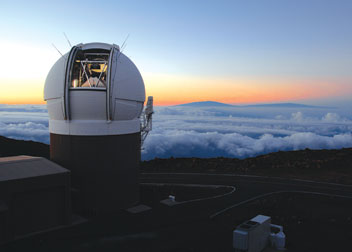Wood-Vasey Leads Search for Supernovae, Black Holes for International Telescope Project
 Located atop Hawaii’s Haleakala volcano, the Pan-STARRS 1 telescope is the world’s most powerful digital camera and includes a refrigerator-sized 1.4 billion-pixel camera that will snap about 500 pictures nightly, each of a swath of sky six times wider than the moon.
Located atop Hawaii’s Haleakala volcano, the Pan-STARRS 1 telescope is the world’s most powerful digital camera and includes a refrigerator-sized 1.4 billion-pixel camera that will snap about 500 pictures nightly, each of a swath of sky six times wider than the moon.A University of Pittsburgh physics and astronomy professor will lead a multiyear effort to use the world’s most powerful digital camera to search the sky for explosive and violent deep-space events that could help astronomers better understand cosmic activity, from the universe’s expansion to the savage interaction of stars and black holes.
Michael Wood-Vasey, an assistant professor in the Department of Physics and Astronomy in Pitt’s School of Arts and Sciences, and a group of 10 scientists around the world will identify supernovae, gamma ray bursts, and tidal disruption events—when black holes rip young stars apart—that appear in images captured by the newly operational PS1 telescope managed by the University of Hawaii-based Pan-STARRS (Panoramic Survey Telescope and Rapid Response System) consortium. The PS1 is located atop Hawaii’s Haleakala volcano and includes a refrigerator-sized 1.4 billion-pixel camera that will snap about 500 pictures nightly, each of a swath of sky six times wider than the moon. The PS1 is the first of four digital telescopes planned under the Pan-STARRS project. More information and telescope images are available on the Pan-STARRS Web site at www.pan-starrs.ifa.hawaii.edu
Pitt researchers are involved in a large number of international telescope projects, of which Pan-STARRS is the latest. The particularly active cosmology group in Pitt’s physics and astronomy department participates in projects ranging from the longest single project ever carried out with the Hubble Space Telescope to capturing color images of a strip of sky that document the past 10 billion years of galactic evolution. Wood-Vasey also is Pitt’s lead representative for the Sloan Digital Sky Survey III, an international effort to better understand dark energy, the structure of planetary systems, and the genesis of the Milky Way.
For Pan-STARRS, Wood-Vasey’s group will search PS1 images for transient events, as space’s more intense phenomena are known because of their typically short duration. As they observe new events, the team will provide real-time updates to any of the 300 Pan-STARRS scientists worldwide on the lookout for these bursts of cosmic activity, which can reveal information about the universe’s basic structure. Wood-Vasey himself will focus on the various ways a star can meet its end, including tidal disruption events and Type Ia supernovae, the explosive byproducts of dying white dwarf stars. Type Ia supernovae also emit a consistent amount of light, so any variation in their visible brightness could be used to help gauge the rate of the universe’s expansion and understand the nature of the as-yet-undetected dark energy thought to make up most of the universe’s mass.
A video that Wood-Vasey captured with the PS1 in February shows a Type Ia supernova explosion—seen as a blue flash—420 million light years from Earth and is available on Pitt’s Web site at www.pitt.edu/news2010/Supernova_Explode.gif
The PS1 is the precursor to another international project involving Pitt—the multimillion-dollar Large Synoptic Survey Telescope (LSST). The University of California at Davis-based undertaking involves scientists from 23 partner institutions, including researchers from Pitt’s physics and astronomy and computer science departments. The 14-year effort will result in the construction of the world’s largest digital camera (3 billion pixels) and record the movement and development of the universe in a color movie of the sky.
Other Stories From This Issue
On the Freedom Road

Follow a group of Pitt students on the Returning to the Roots of Civil Rights bus tour, a nine-day, 2,300-mile journey crisscrossing five states.
Day 1: The Awakening
Day 2: Deep Impressions
Day 3: Music, Montgomery, and More
Day 4: Looking Back, Looking Forward
Day 5: Learning to Remember
Day 6: The Mountaintop
Day 7: Slavery and Beyond
Day 8: Lessons to Bring Home
Day 9: Final Lessons

